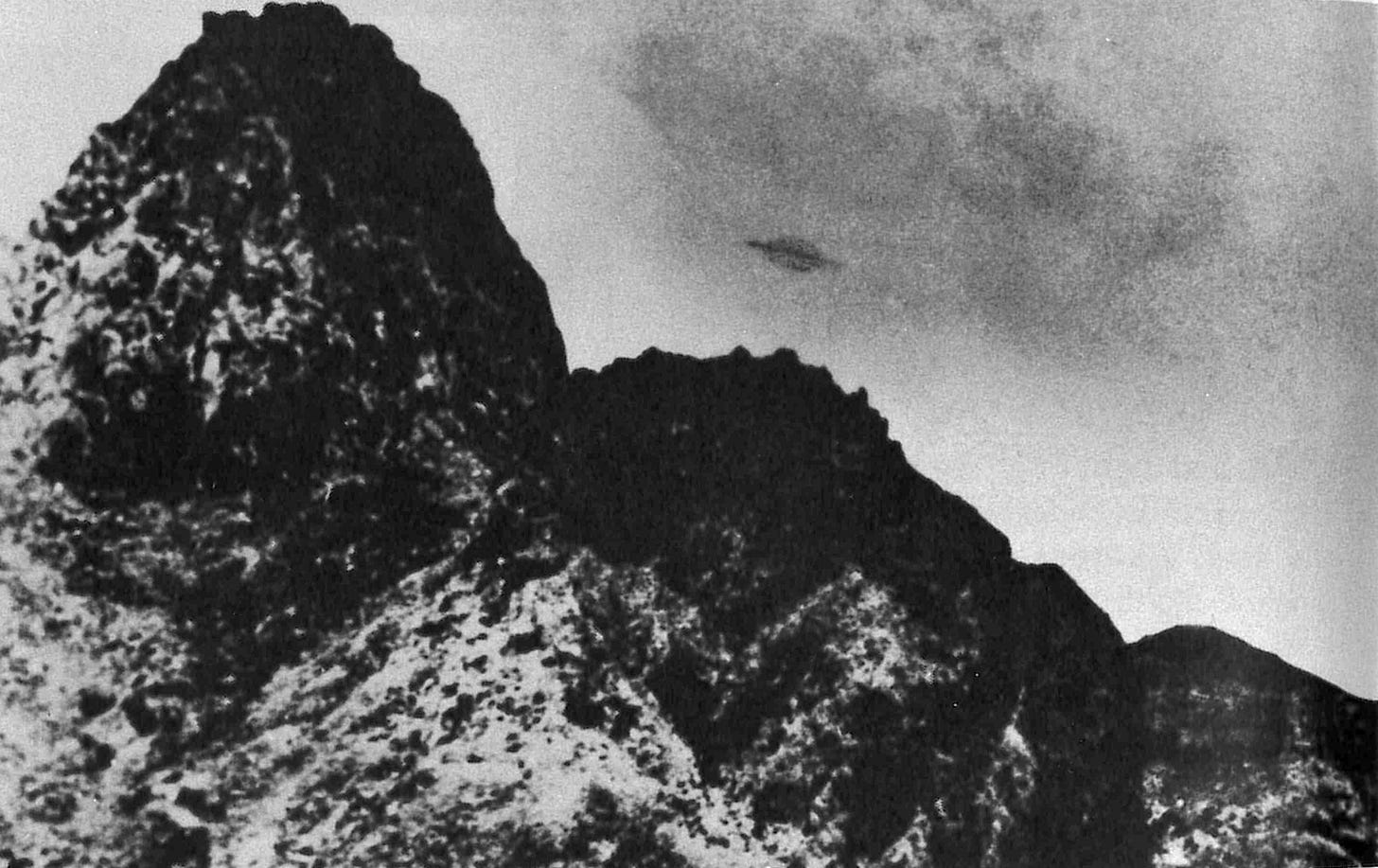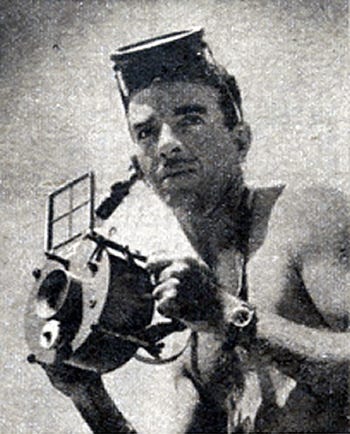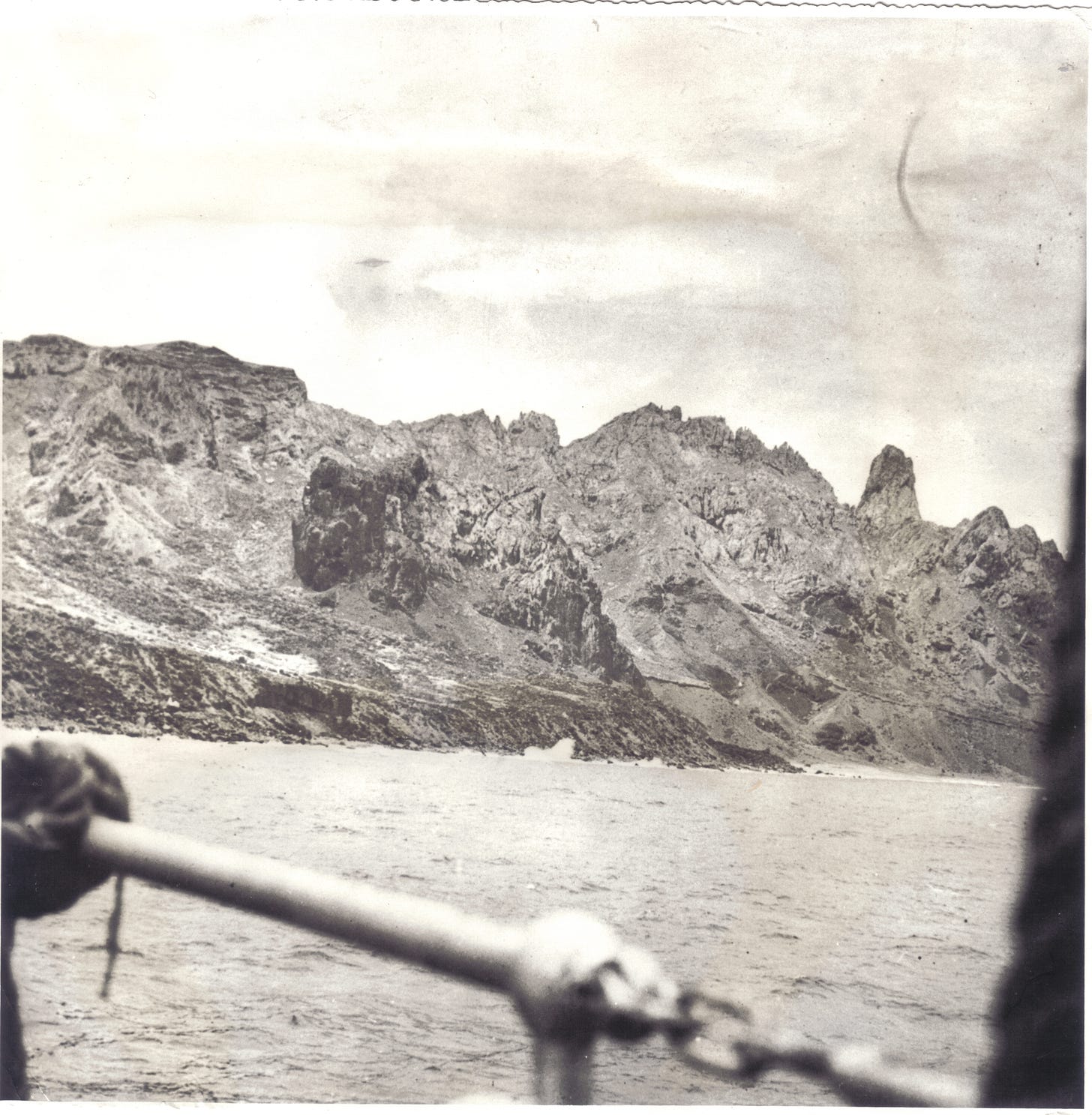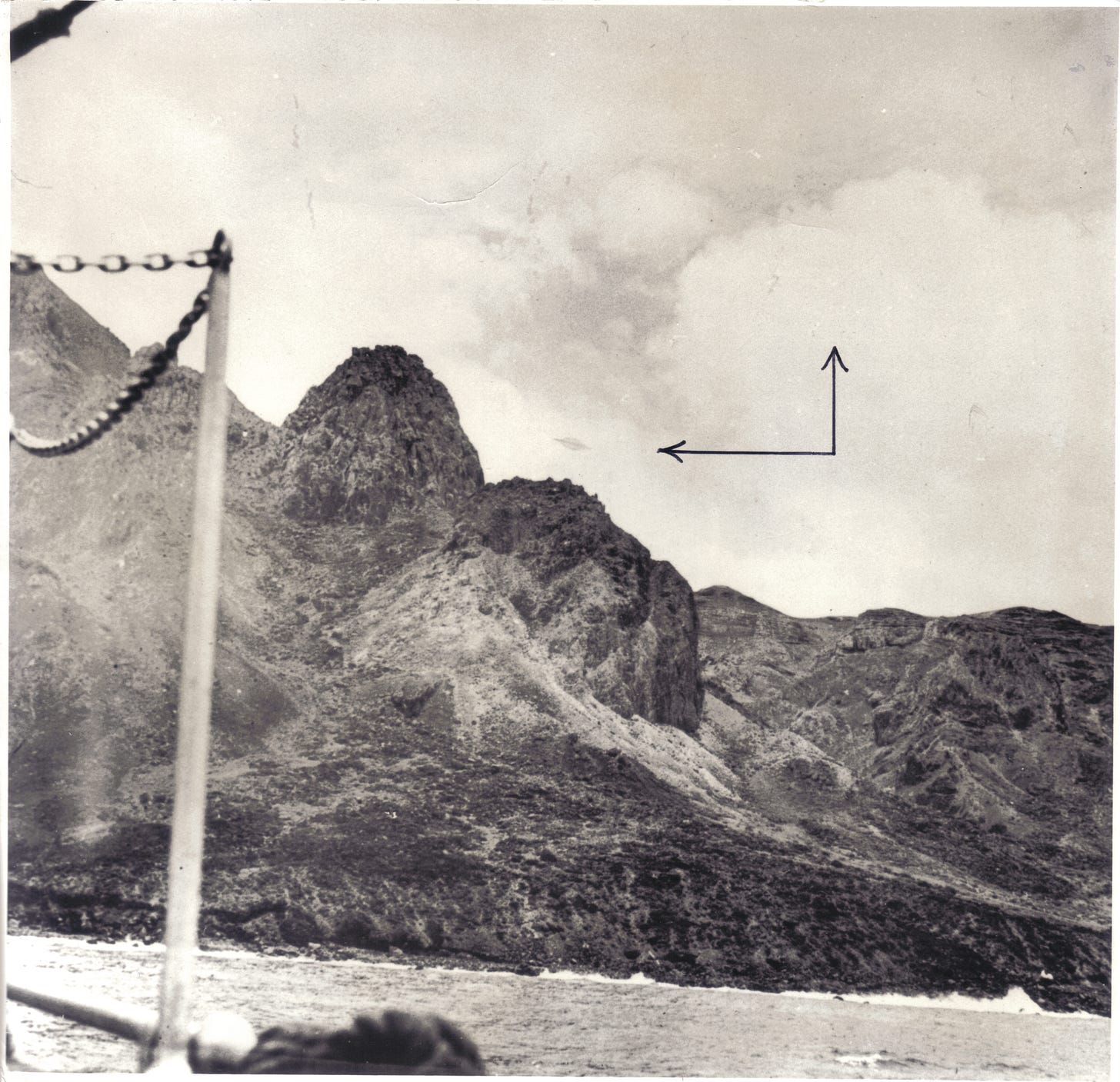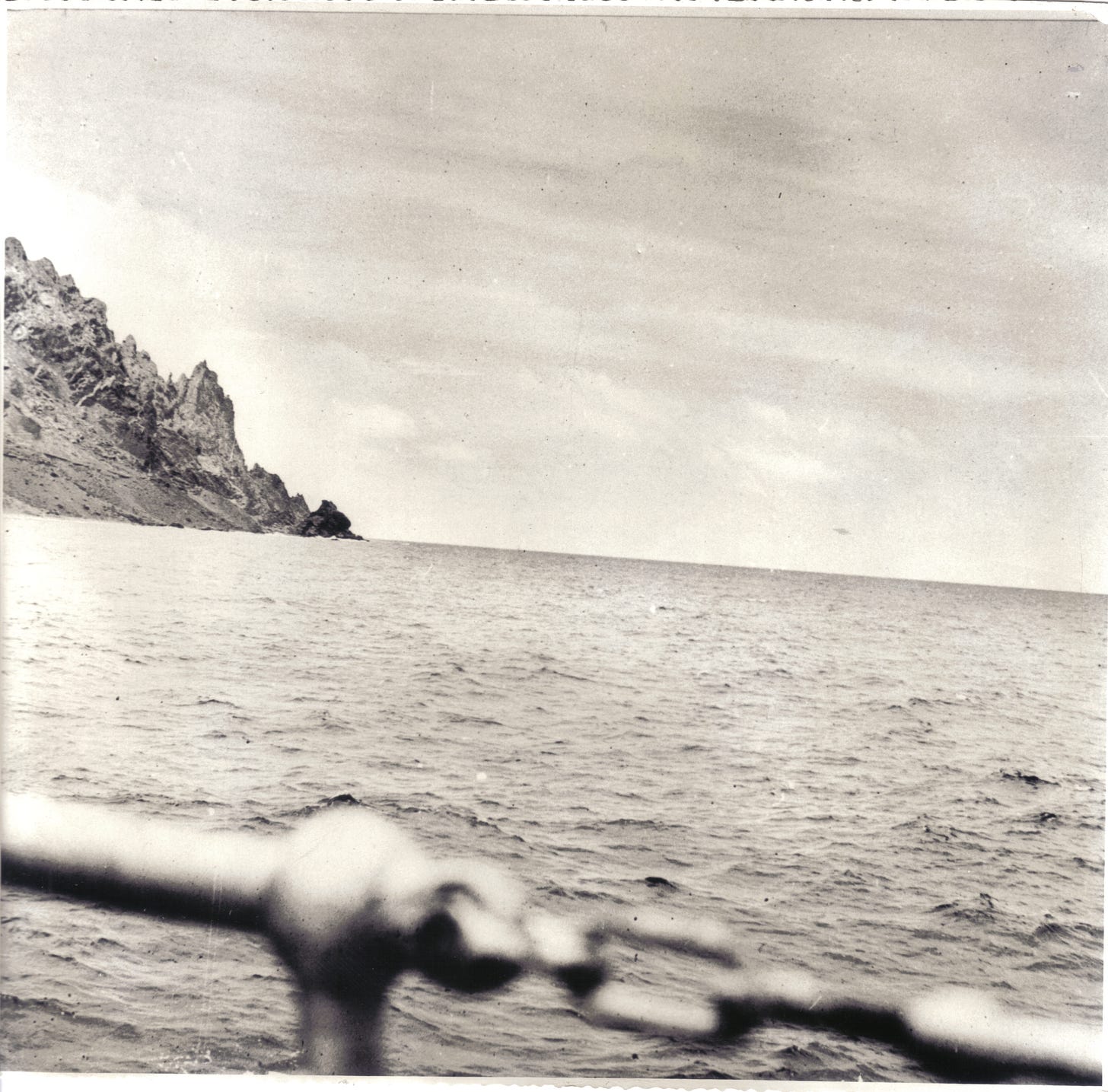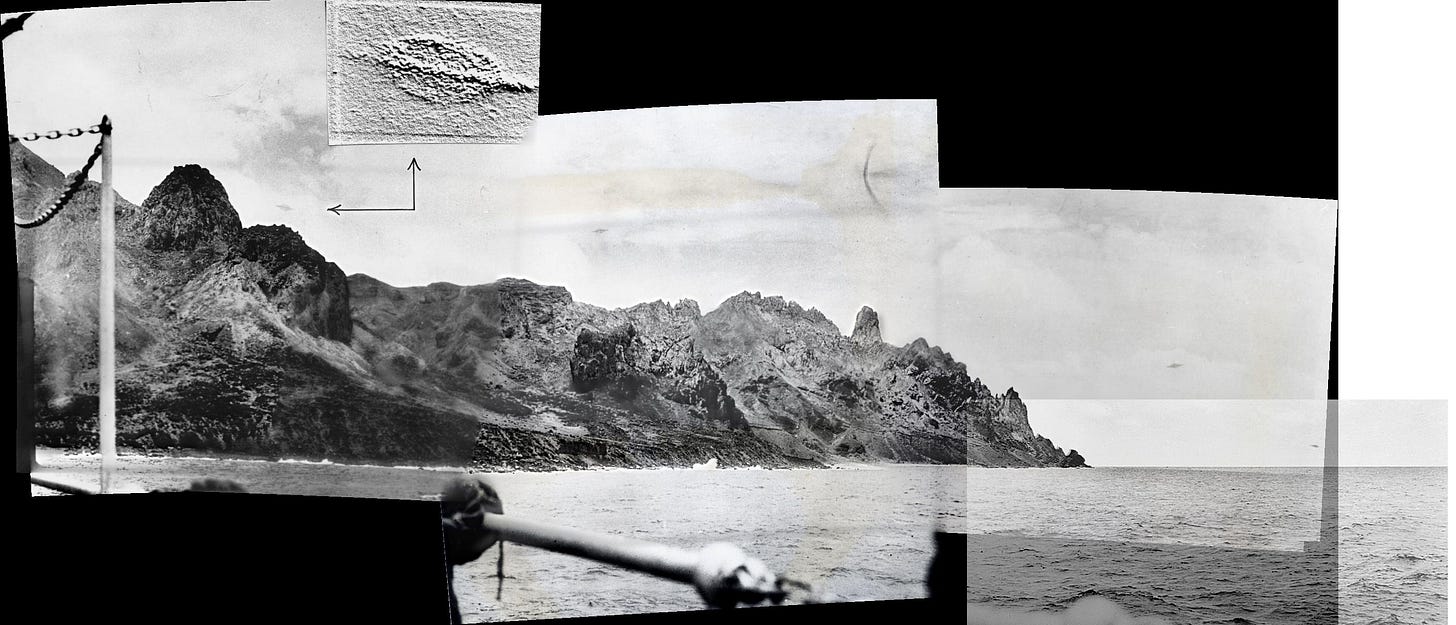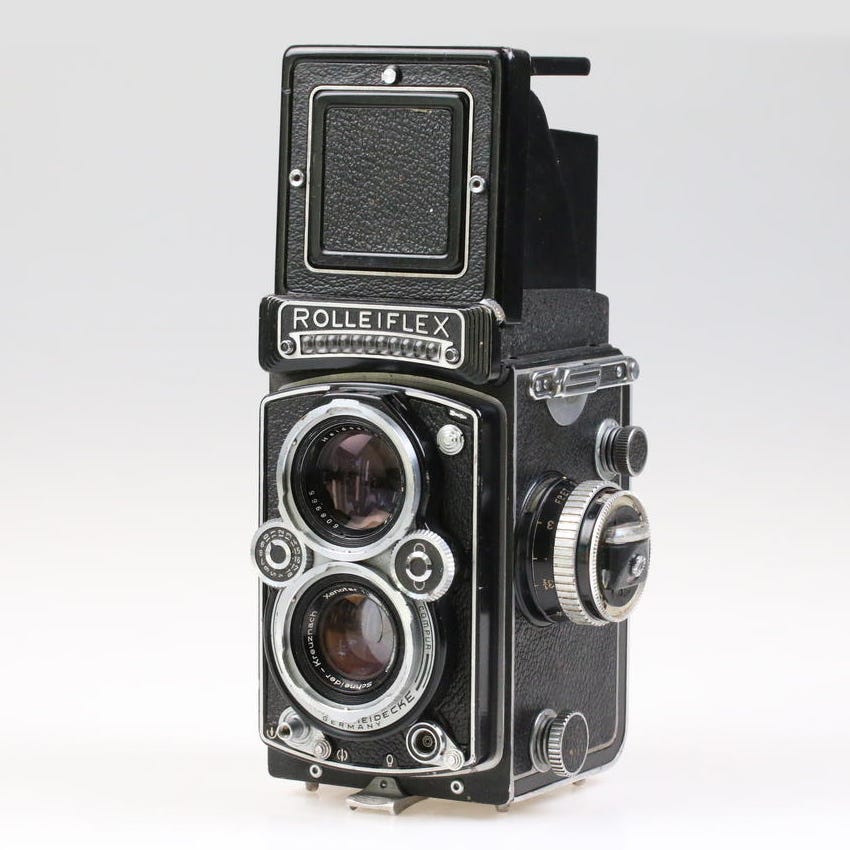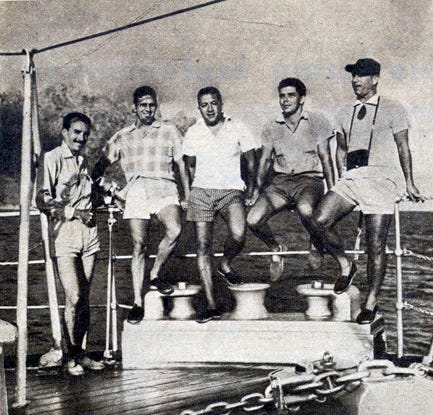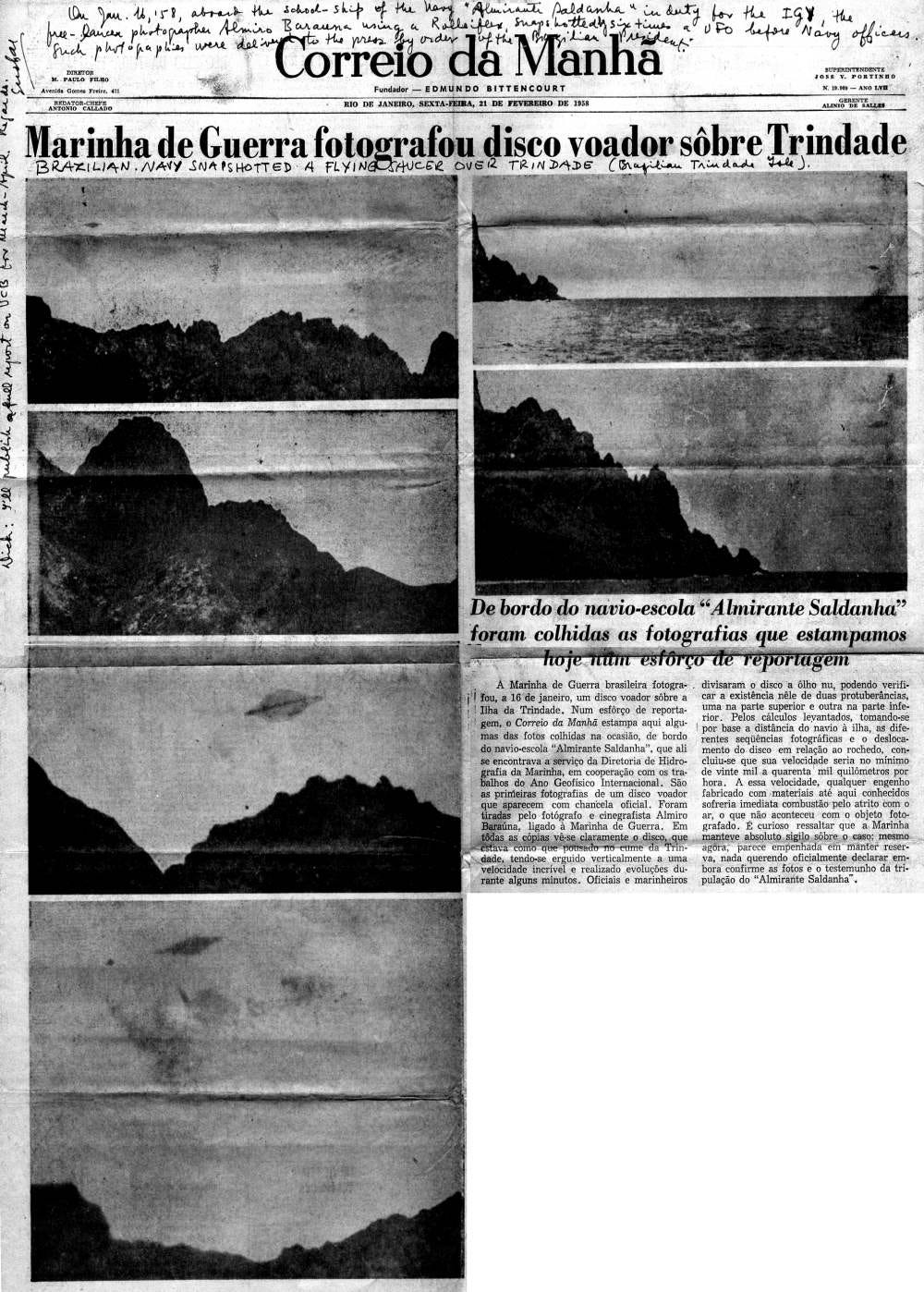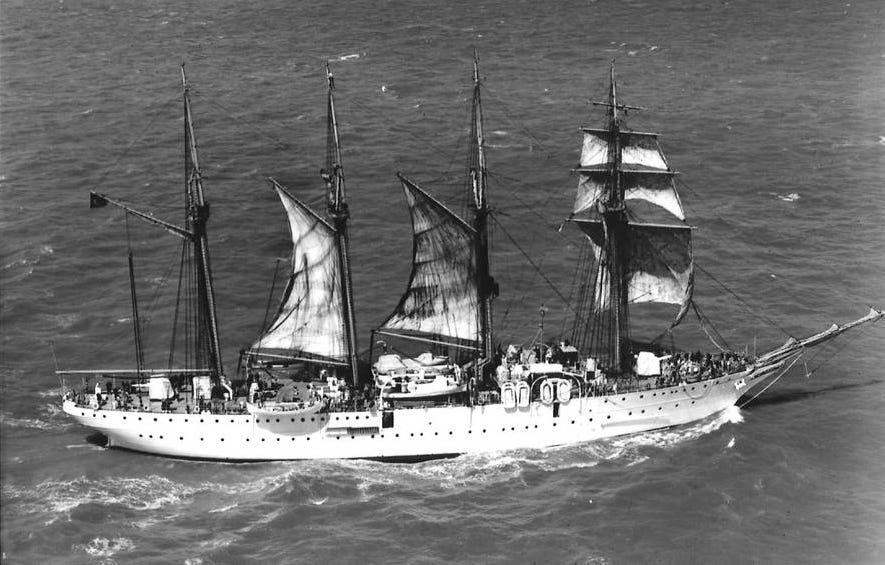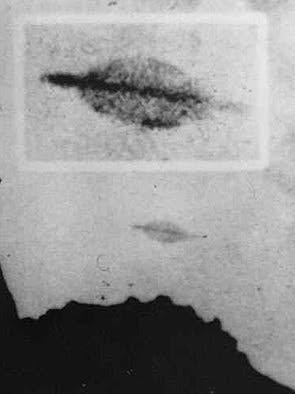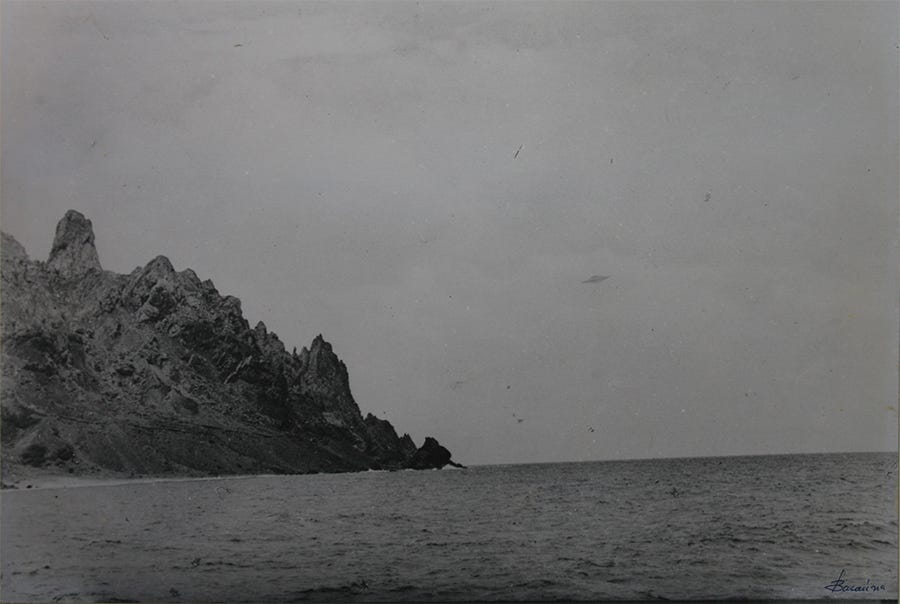The Baraúna UFO Photographs
Flying Saucer tours Trindade for the International Geophysical Year of 1958
“FLYING SAUCER, HO!” yelled the look-out. He pointed toward a bright spot zooming in from the open ocean to the east. Tracking about 1,600 feet over the surface, a gray object shaped like the planet Saturn approached at about 500 miles per hour and within seconds reached the nearby island.
Trindade Island, a craggy and barren shard of volcanic rock, juts from the Atlantic Ocean about 700 miles east from its mainland, Brazil. In its lee to the south, the Brazilian Navy Training ship Almirante Saldhana lay at anchor.
A four-masted tall ship, the main deck was filled with sailors, scientists and adventurers on January 16, 1958. At least 48 would attest in writing that they saw some thing that looked and acted like it came from another world. Backing them up were as many as 100 crewmates on the ship and island, plus four photographs that captured images of what they had seen: a flying saucer.
All the crew were participants in an official Brazilian expedition sent to explore the island and its underwater environs as part of the International Geophysical Year (IGY) of 1958. The IGY was a program initiated by the United Nations and scientists from around the world for a comprehensive study of the Earth, its poles, its atmosphere, and its interactions with the Sun.
As part of the IGY, the USSR and the USA launched their first satellites, Sputnik in 1957 and Vanguard in 1958. Both stand among the greatest technological achievements of man. It was Brazil, however, that stole the cosmic show in ‘58.
Preparing to take photos of the crew’s activities was Almiro Baraúna, a professional lensman who was a pioneer in underwater photography. At the time of the sighting, he had been observing a jolly boat as it was lowered to retrieve scientists and crew from Trindade Island.
Mr. Baraúna was surprised when the boat suddenly stopped a short distance above the water. The electric winch had conked out. Brazilian Navy investigators asked the eyewitnesses not to refer to the apparent electromagnetic interference created by the UFO, which may have interfered with the ship’s electric system.
At that moment, a wave of excitement washed over the deck of the Almirante Saldhano as word of the alert spread. Sailors, scientists and spearfishers mader way through rigging, cargo and each other to the port gunwale. There they stood, elbowing each other in disbelief, as they watched the object zoom in from the sea.
Mr. Baraúna and other witnesses said it looked and performed like a machine under intelligent control. Some reported the object appeared to be enveloped in a light phosphorescent green glow, perhaps more prominent toward the leading edge.
Shaped somewhat like a flattened planet Saturn, the silvery-grey object passed above Galo Crest, an obelisk-like peak, and for a moment was lost to sight as it passed behind Pico Desejado, a 2,030-foot tall spire. The object the reappeared from behind the mount, looking larger and lower in altitude. Then, it continued back out to sea.
Mr. Baraúna said he spent about 30 seconds spotting the object. Then he got to work, taking six photos in about 14 seconds.
“It made no noise, although with the shouting of the people on the deck and the noise of the sea, I cannot be certain,” Baraúna said. “It had a metallic look, of an ash color, and has like a condensation of a green vapor around the perimeter, particularly in the advancing edge. Its motion was undulating, like the flight of a bat.”
Mr. Baraúna might’ve gotten six photos of the UFO, but his excited crewmates bumped into the photographer causing him to miss the UFO on two exposures. Nevertheless, he and his Rolleiflex 2.8E Twin Lens Reflex camera managed to produce four of the best photographic images ever taken of a flying saucer.
The composite above includes the four images. They have been cropped in order to show the object’s position in flight, relative to Trindade Island and the ship’s rail. From left to right, the sequence in which they were taken: 3-2-1-6.
The photographs show what Mr. Baraúna and the other eyewitnesses reported seeing: a Saturn-shaped artificial object approaching from the open Atlantic and departing in the same general direction. Adding weight to the veracity of the images, the event was witnessed by a large number of highly trained observers.
The object was estimated to be flying at about 1,600-feet altitude at a speed between 550 and 600 mph. Photometry suggested the object was about 120-feet in diameter and about 24 feet in height.
The insert with arrow shows the portion of one negative where the object appears. The grain structure, the light sensitive silver-halide particles that make up the black-and-white film emulsion, reveals that the object was a solid object, photographed at the same time as the rest of the image was made.
NICAP reports: “ALMIRANTE SALDANHA” was anchored close to the point near the “Galo Crest” Peak and photographer Barauna was at the stern. The UAO was first seen over the sea, coming toward the island. The first photo was taken at position 1, with the object flying at low speed. Photo number 2 was shot when it was placed behind the “Galo Crest.” Photo 3 was taken a few seconds after the turn made by the UAO near “Desejado” Peak. Photos 4 and 5 failed to the register the UAO, which was then flying at high speed. The last picture, number 6, was taken when the object was moving away close to the horizon line. It disappeared a few seconds later.
From sighting to departure over the South Atlantic, the event lasted about 45 seconds. As many as 100 of the ship’s company are believed to have seen the UFO. Thankfully, in that short and chaotic time frame, Almiro Baraúna maintained the presence of mind to use his camera, a Rolleiflex 2.8E, similar to the model pictured below. Analysis of the object, mountains and forms photographed by Baraúna support the veracity of the photographs and the testimony of eyewitnesses, as well.
The contemporary reporting from the time makes most compelling history for us today. Dr. Olavo T. Fontes, MD, was a Brazilian physician and writer who personally investigated the case, interviewing eyewitnesses and investigators, as well as preserving and sharing vital documentation. In my opinion, Dr. Fontes accurately reported one of the most amazing things to happen during the International Geophysical Year of 1958 or in any year.
Mr. Barauna is first on the left in the image above of the Icarai Spearfishing Club, taken on the Almirante Saldhana.
Dr. Fontes in 1960 reprinted the following from O Cruzeiro, an interview of photographer Almiro Baraúna by reporter Joao Martins published March 8, 1958.
“Q. Mr. Baraúna, what were the reasons for your presence aboard the NE ‘Almirante Saldanha’?
A. The Navy has invited several teams specialized in submarine hunting to visit the Island of Trindade. I am a member of the Icarai (Spearfishing) Club for Submarine Hunting, and our group was invited for the last trip. So, on January 8, when the ship left Rio, I was aboard together with the following members of my group: Amilar Vieira Fliho, captain of our team, a Government employee (he has a job at the CACEX); Jose Teobaldo Viegas, instructor at the Aero Club of Niteroi and Air Force Captain (retired); Mauro Andrade, from the London Bank; and Aloislo, municipal employee at the Federal District. We were going to try to beat some records on submarine hunting. Personally, I was going to take underwater photographs for the Navy, and also to write some articles about the Island and the activities of the scientists working for the IGY.
“Q. Was any other civilian aboard, besides your group?
A. Yes. There was Prof. Fernando, a geologist, with two assistants, and also a photographer, and a reporter from the newspaper ‘JORNAL DO BRASIL’. The three scientists left the ship and went to the island.
“Q. Please tell me, what was the date of the sighting? What happened?
A. It was on January 16, at 12:15 p.m. The ship was preparing to leave the island, to come back to Rio. I was on the deck observing the operations to take aboard the boat used in the trips between the ship and the island (the island has no harbor). The sea was agitated. The weather was cloudy, clear, with no shadows. I had my Rolleiflex 2.8—model E, which was kept inside an aluminum box for protection against the corrosive effects of water and salt. I had left by Leica with a telephoto lens in my cabin a few moments before. The deck was full of sailors and officers. Suddenly, Mr. Amilar Vieira and Captain Viegas called me, pointing to a certain spot in the sky and yelling about a bright object which was approaching the island. At this same moment, when I was still trying to see what it was, Lieutenant Homero—the ship’s dentist—came from the bow toward us, running, pointing out to the sky and also yelling about an object he was sighting. He was so disturbed and excited that he almost fell down after colliding with a cable. Then I was finally able to locate the object, by the flash (of light) it emitted. It was already close to the island. It glittered at certain moments, perhaps reflecting the sunlight, perhaps changing its own light—I don’t know. It was coming over the sea, moving toward the point called the ‘Gab Crest’. I had lost 30 seconds looking for the object, but the camera was already in my hands, ready, when I sighted it clearly silhouetted against the clouds. I shot two photos before it disappeared behind the peak ‘Desejado’. My camera was set at speed 125, with the aperture at f/8, and this was the cause of an over-exposure error, as I discovered later.
“The object remained out of sight for a few seconds—behind the peak—reappearing bigger in size and flying in the opposite direction, but lower and closer than before, and moving at a higher speed. I shot the third photo. The fourth and fifth ones were lost, not only because of the speed the saucer was moving, but also for another reason: in the confusion produced as a result of the sighting, I was being pulled and pushed by other persons also trying to spot the object and, as a consequence, photographed the sea and the island only—not the object. It was moving again toward the sea, in the direction from which it had come, and it appeared to stop in mid-air for a brief time. At that moment I shot my last photo (the last on the film). After about 10 seconds, the object continued to increase its distance from the ship, gradually diminishing in size and finally disappearing into the horizon.
“Q. Did you hear anything unusual during the sighting? Was the object emitting any sound?
A. I am not sure, to be honest, because of the noise made by the sea waves against the island’s rocks, as well as for the yelling aboard the ship at the time. However, I think that I heard nothing besides those sounds.
“Q. What was the color of the object?
A. It showed a dark grey color, appearing to be surrounded—mostly in the area ahead of it—by a kind of condensation of a greenish, phosphorescent vapor (or mist).
“Q. Did the object appear to be metallic?
A. Yes. It was obviously a solid object.
“Q. How was it flying? Any special characteristic?
A. Yes. It showed an undulatory movement as it flew across the sky, like the flight of a bat. And when it came back, it changed speed abruptly, with no transition, in a jump.
“Q. Do you know how many persons aboard the ‘Almirante Saldanha’ sighted the object?
A. The object was sighted by almost all the people on the deck at that time, including Lieutenant Homero, Captain Viegas and Mr. Amilar Vieira.
“Q. What happened after the sighting?
A. The ship’s commander and several officers from the garrison wanted to see what I had got in the photos. As I was very curious too, I decided to develop the exposed film at once, aboard the ship. The processing was done under the supervision of several officers, including Com. Carlos A. Bacellar. But only the negatives were seen aboard. The reason: there was no photographic paper for the copies on the ship at that time. The negatives, however, were seen and examined by the whole crew.
Source: “The UAO Sightings at the Island of Trindade”
by Olavo T. Fontes, MD
APRO Special Representative for Brazil
Under the supervision of Carlos Alberto Ferreira Bacellar, captain of the Almirante Saldanho, photographer Barauna developed the roll of 120 mm film straight from the camera in a makeshift darkroom. Captain Bacellar and other officers were present, while the photographer wore only his swimming trunks, to reduce if not eliminate the possibility of hoax or fraud. After the negatives were developed, all in the crew were invited to inspect them personally. While appearing tiny relative to the rest of the medium format negative, they could see on the film what their eyes saw on deck.
The links in the copy above go to sundry websites with analysis and details. This remarkable episode literally takes us to another time when something that looks like it came from another world paid a visit to an island in the middle of the ocean. Perhaps it serves as an allegory for us today to consider: a ship visiting an island earth, a grain of sand on the beach of a tiny galactic island in the vastness that is the ocean of space. — FJB



